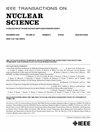质子辐射对DDR5模块影响的实验研究
IF 1.9
3区 工程技术
Q3 ENGINEERING, ELECTRICAL & ELECTRONIC
引用次数: 0
摘要
双数据速率同步动态随机存取存储器(DDR5 SDRAM)作为其家族的最新一代,是未来空间应用的杰出候选者,突出了考虑其辐射性能的重要性。本文首次研究了质子辐射对DDR5双内联内存模块(dual-inline memory module, dimm)的影响。我们对消费级DDR5模块进行了测试,考虑了几个因素,包括质子能量、模块供应商和DDR5上的特定电源管理单元(PMU)。结果提供了单事件效应(SEE)截面(CS)随质子能量的变化曲线,揭示了不同供应商和PMU的敏感性。此外,对服务器级DDR4和DDR5模块进行了对比测试,研究了不同代、外部纠错码(ECC)案例和累积效应的影响。故障注入模拟也进行了识别潜在的原因,在实验中观察到的模式,存在芯片上的ECC。本文章由计算机程序翻译,如有差异,请以英文原文为准。
Experimental Study of Proton-Induced Radiation Effects on DDR5 Modules
Double data rate 5 synchronous dynamic random access memory (DDR5 SDRAM), as the latest generation in its family, is an outstanding candidate for future space applications, highlighting the importance of considering its radiation performance. In this article, we investigated the proton-induced radiation effects on DDR5 dual-inline-memory-modules (DIMMs) for the first time. Consumer-grade DDR5 modules were tested, taking into account several factors, including proton energy, module vendors, and the specific power management unit (PMU) on DDR5. The results provided the single-event effect (SEE) cross section (CS) curve as a function of proton energy and uncovered the sensitivity of different vendors and the PMU. In addition, comparison tests between server-grade DDR4 and DDR5 modules were conducted to study the impacts of different generations, external error correction code (ECC) cases, and accumulated effects. Fault injection simulations were also conducted to identify potential causes for the observed patterns in the experiments with the existence of on-die ECC.
求助全文
通过发布文献求助,成功后即可免费获取论文全文。
去求助
来源期刊

IEEE Transactions on Nuclear Science
工程技术-工程:电子与电气
CiteScore
3.70
自引率
27.80%
发文量
314
审稿时长
6.2 months
期刊介绍:
The IEEE Transactions on Nuclear Science is a publication of the IEEE Nuclear and Plasma Sciences Society. It is viewed as the primary source of technical information in many of the areas it covers. As judged by JCR impact factor, TNS consistently ranks in the top five journals in the category of Nuclear Science & Technology. It has one of the higher immediacy indices, indicating that the information it publishes is viewed as timely, and has a relatively long citation half-life, indicating that the published information also is viewed as valuable for a number of years.
The IEEE Transactions on Nuclear Science is published bimonthly. Its scope includes all aspects of the theory and application of nuclear science and engineering. It focuses on instrumentation for the detection and measurement of ionizing radiation; particle accelerators and their controls; nuclear medicine and its application; effects of radiation on materials, components, and systems; reactor instrumentation and controls; and measurement of radiation in space.
 求助内容:
求助内容: 应助结果提醒方式:
应助结果提醒方式:


